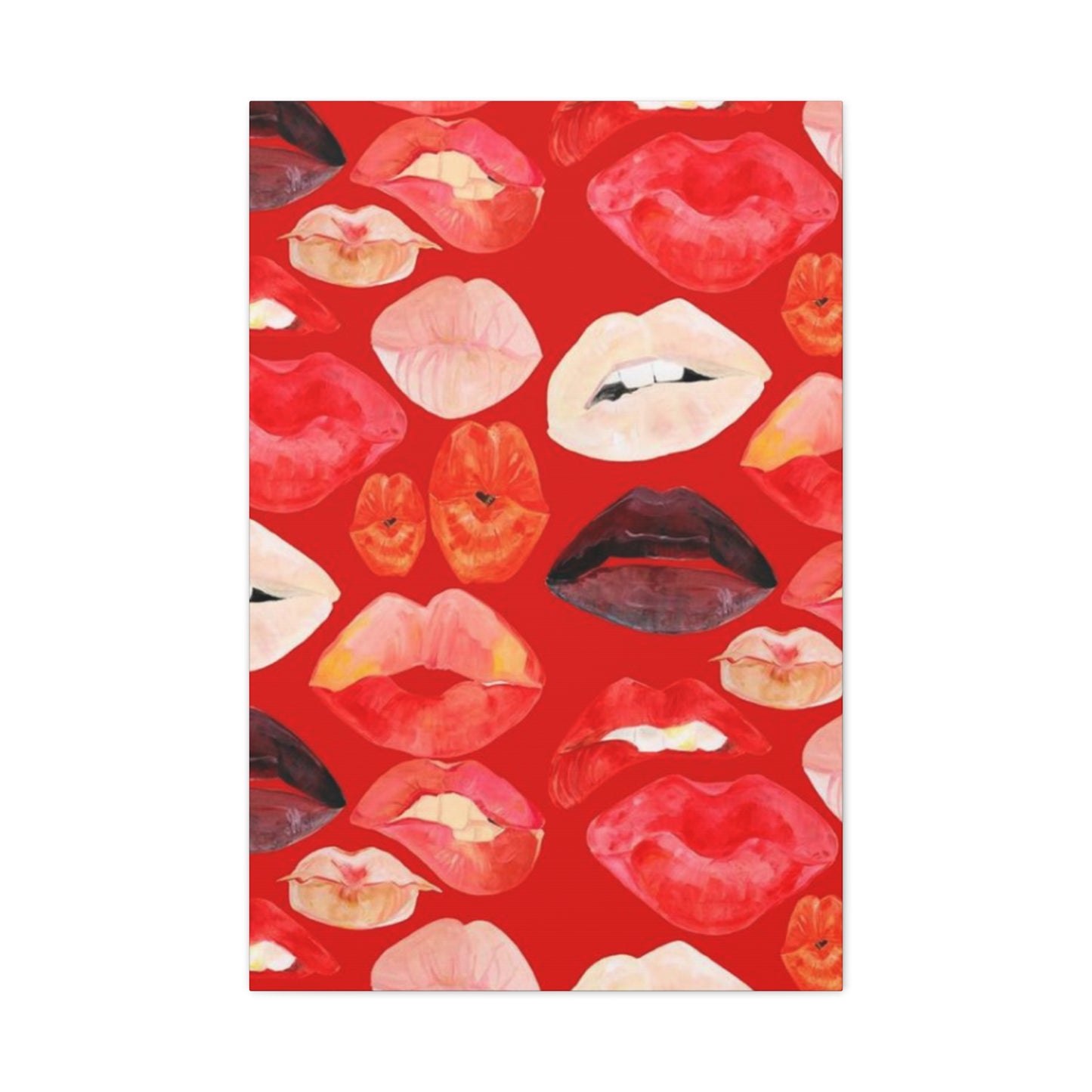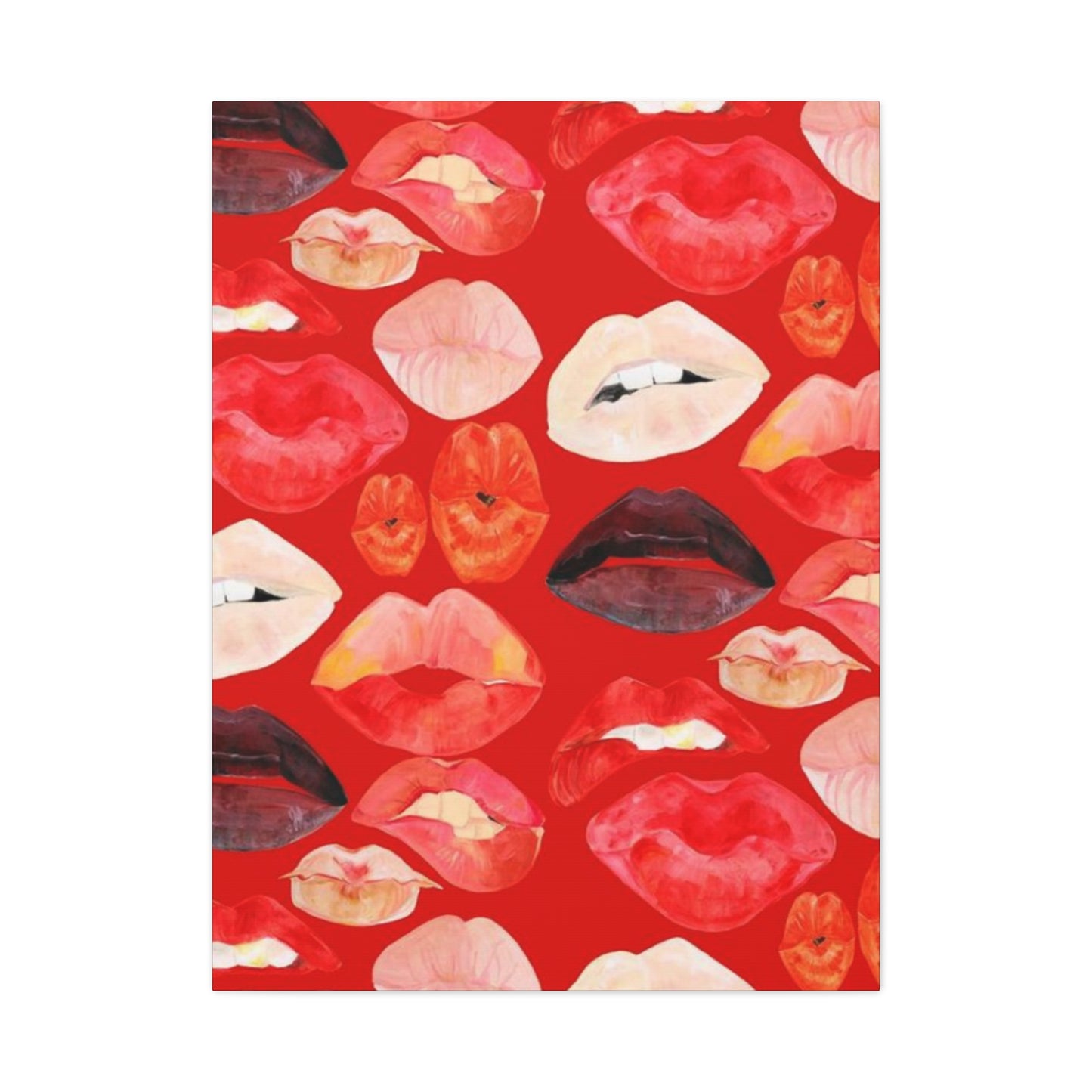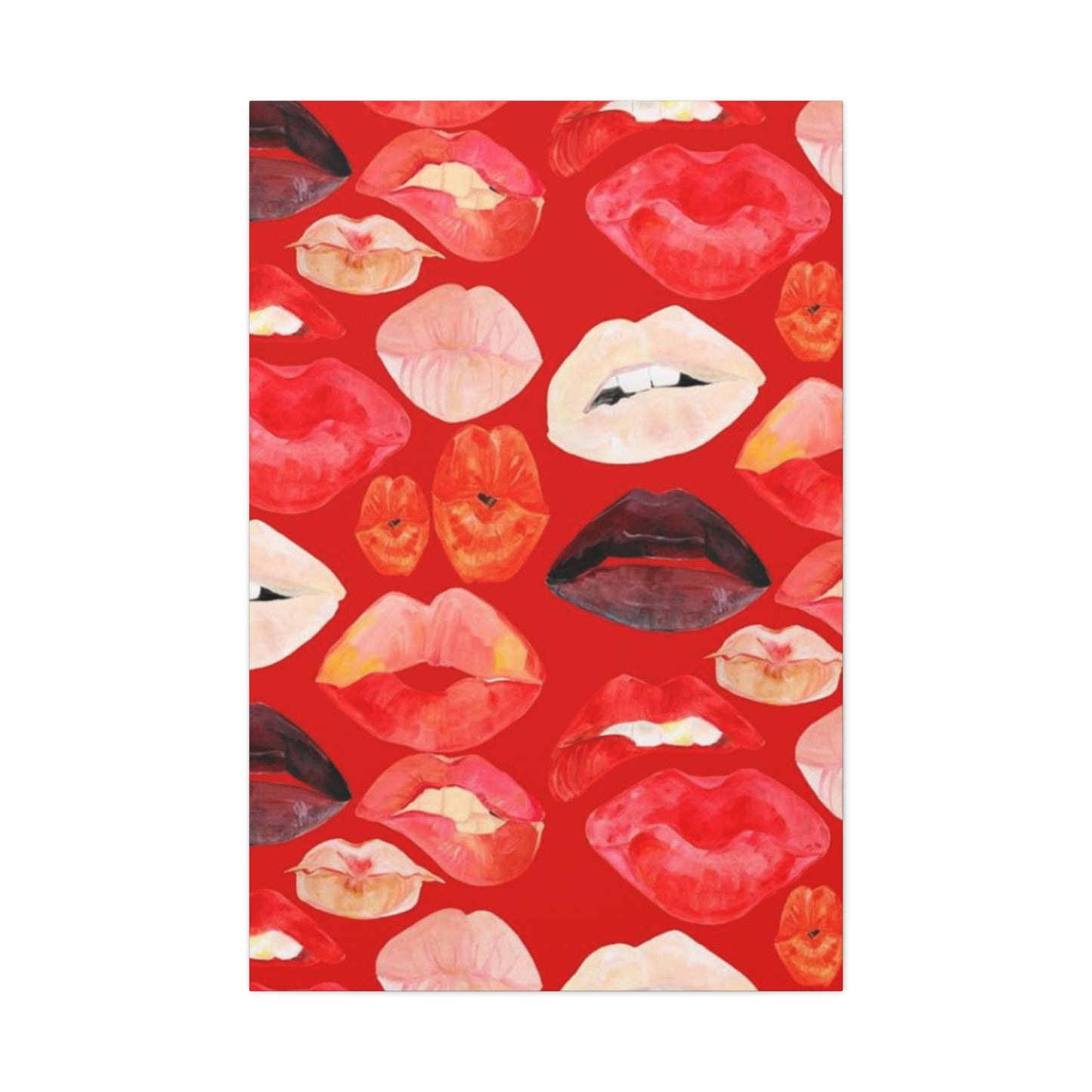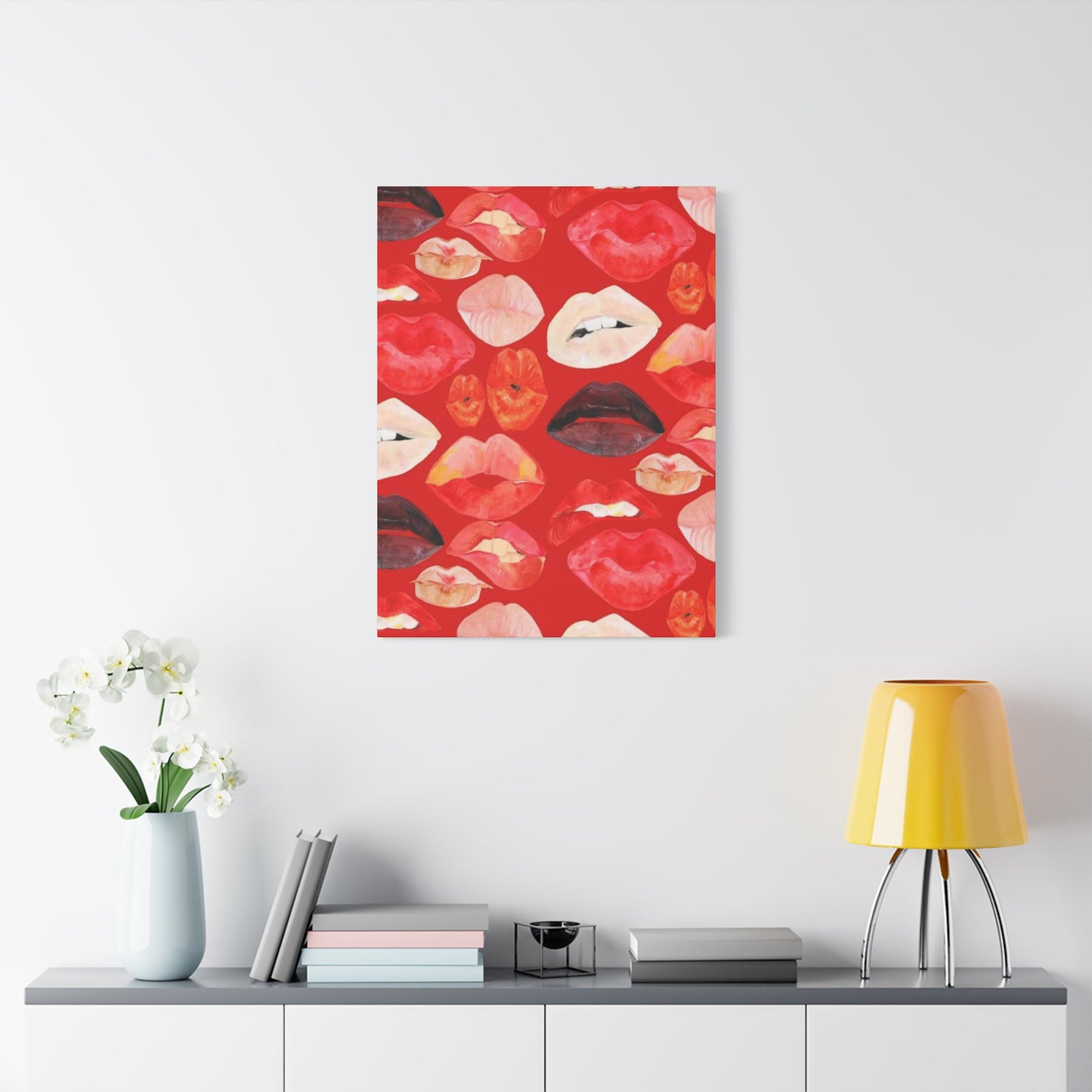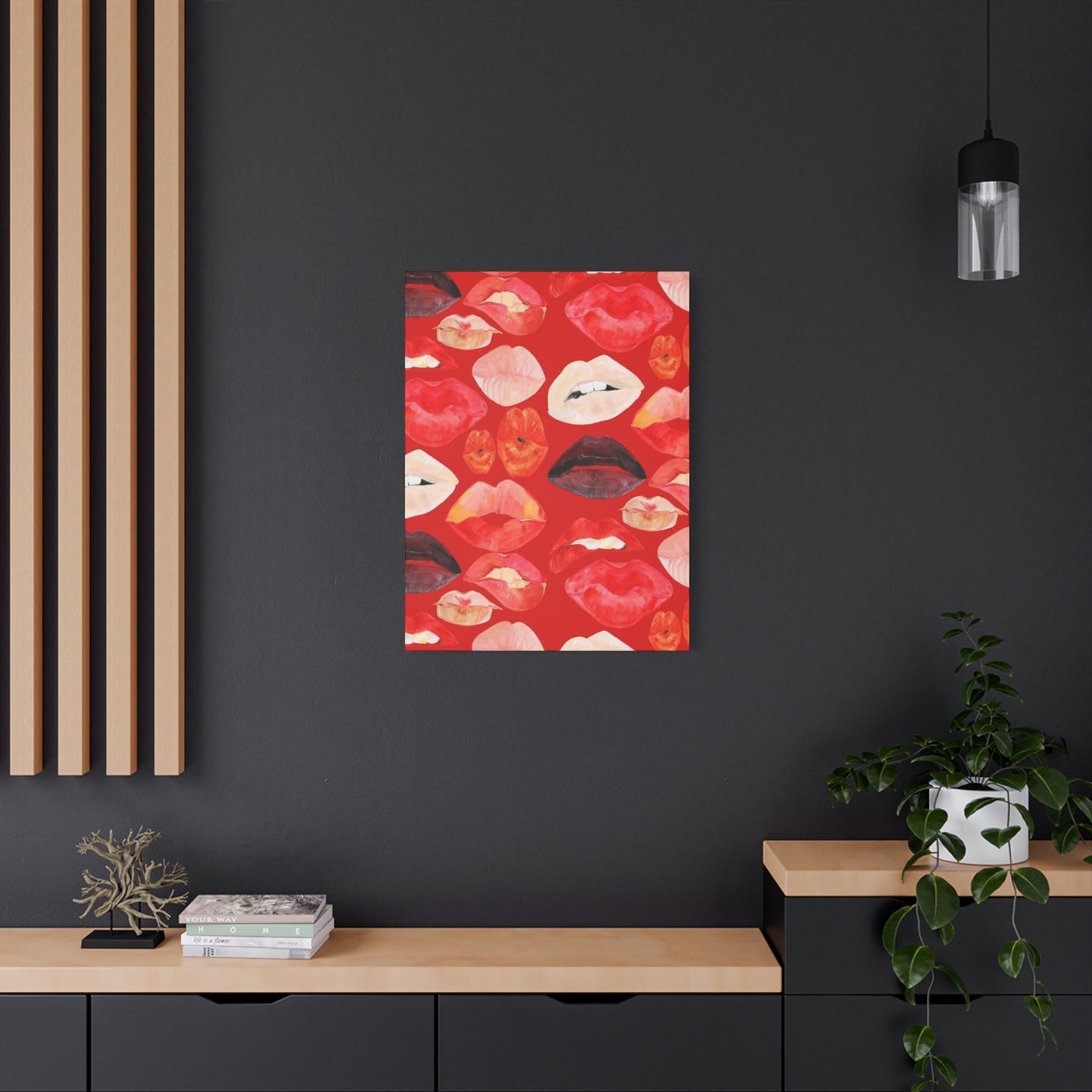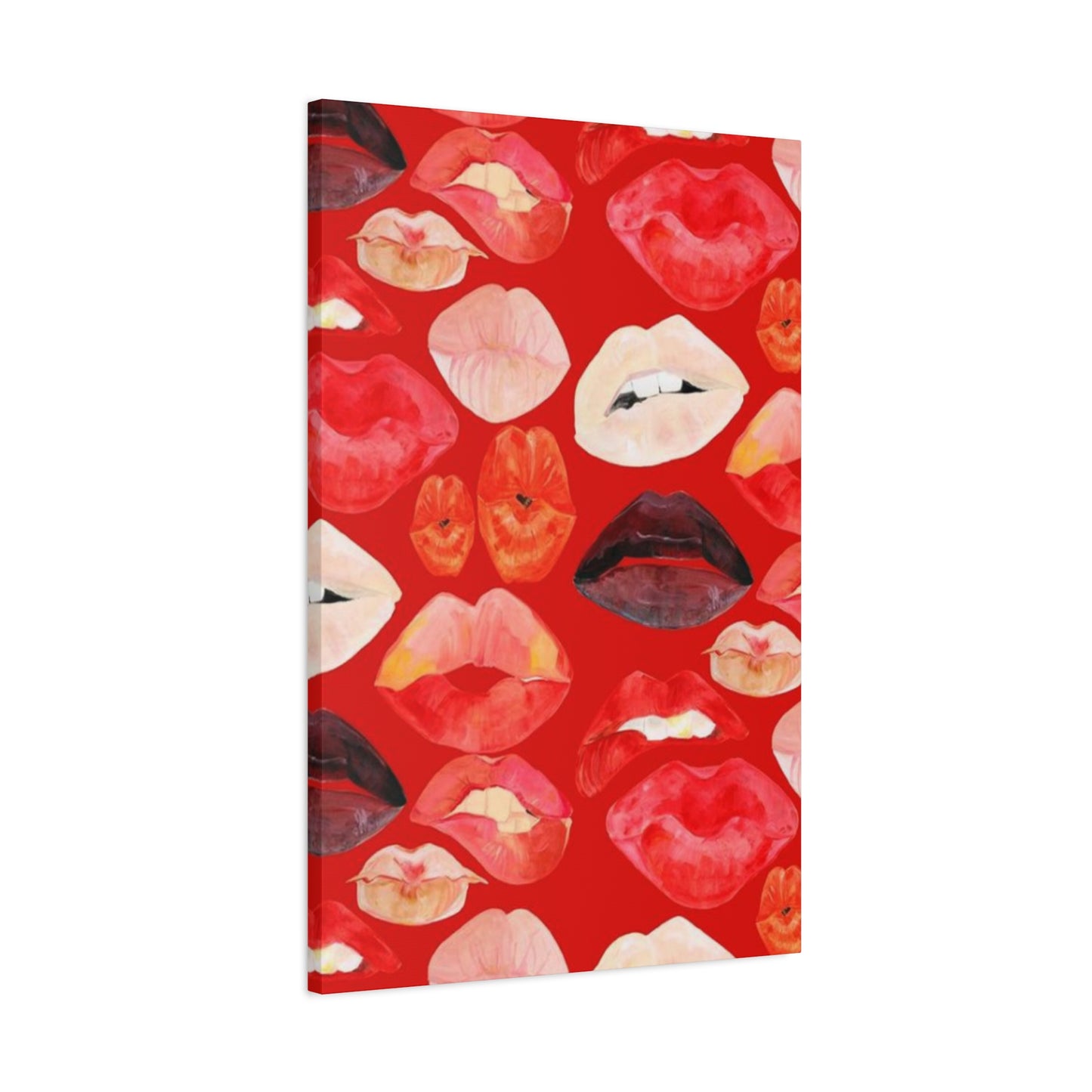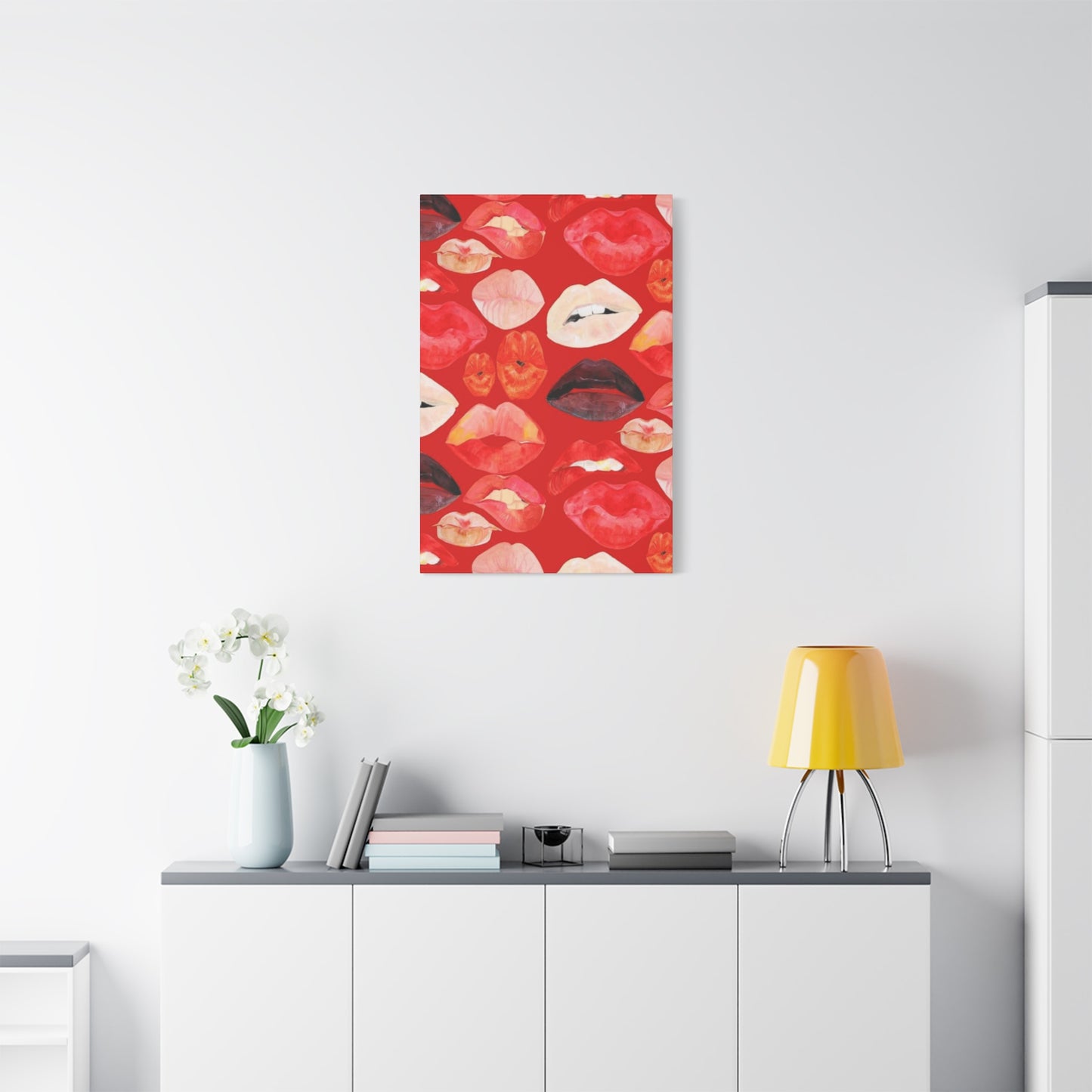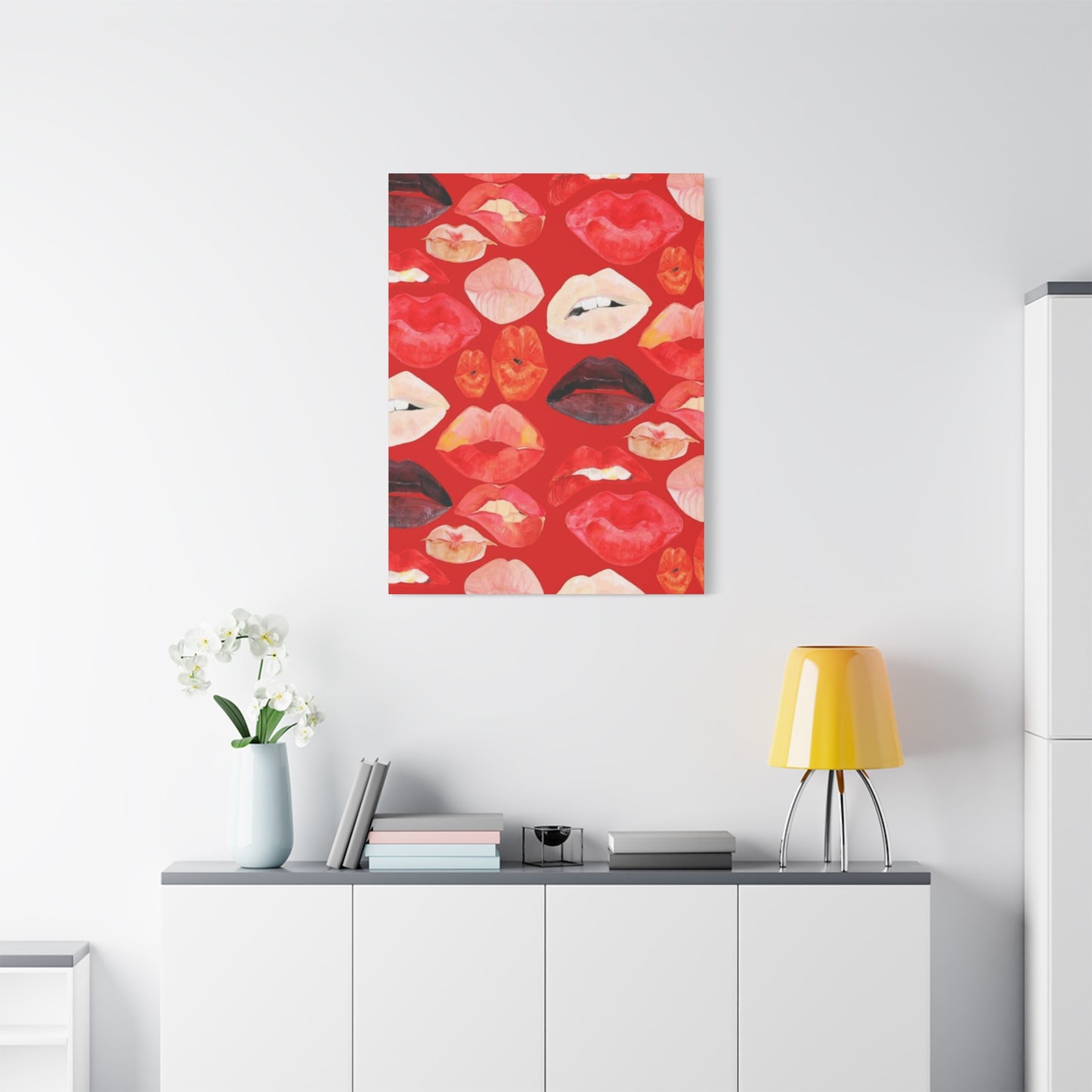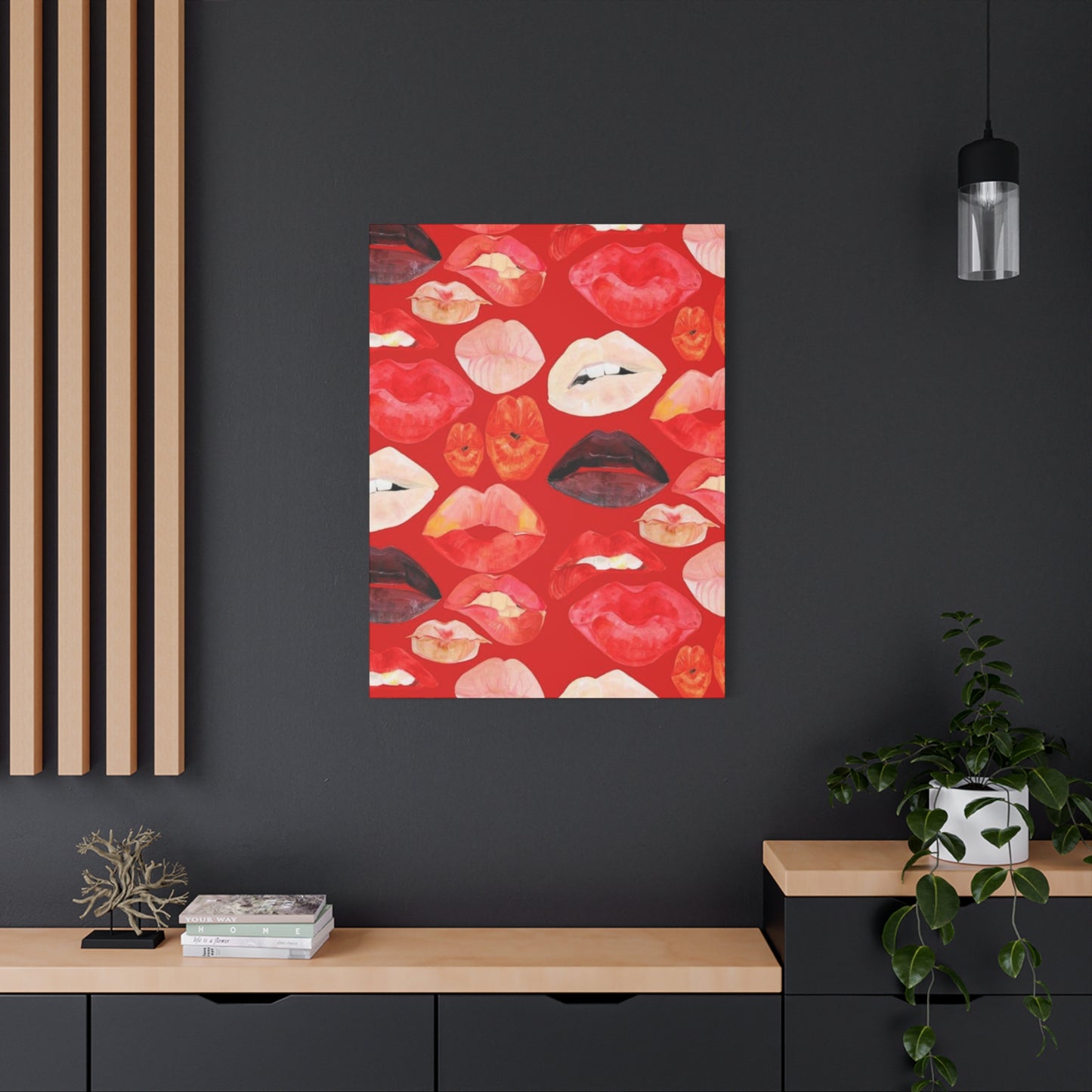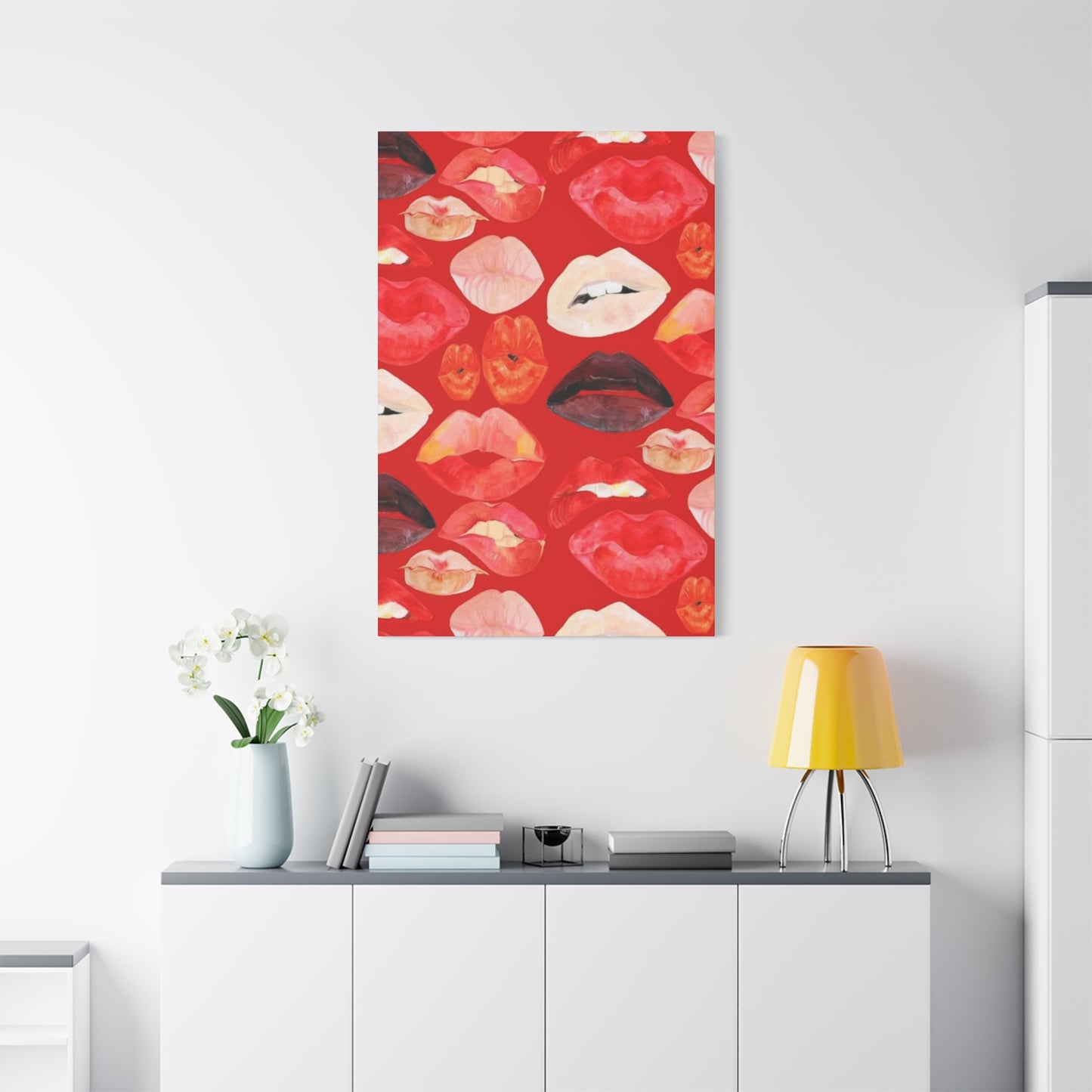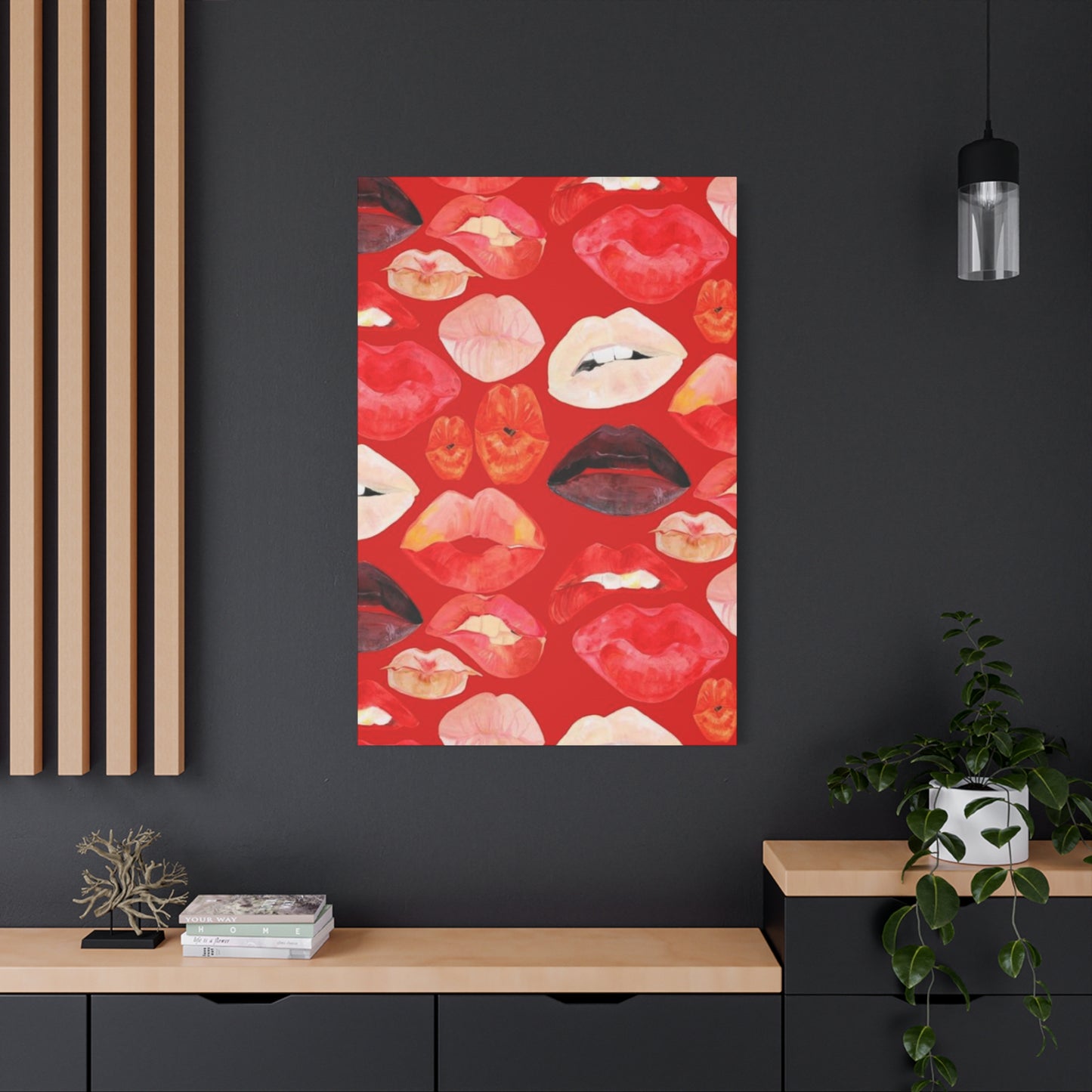The Allure of Lips Painting Wall Art: From Pop Art to Abstract Expressionism
The intersection of sensuality and playfulness creates an irresistible visual language that has dominated interior design trends for decades. Mouth imagery combined with cherry symbols represents more than mere decoration; it embodies a cultural movement that celebrates boldness, femininity, and artistic rebellion. This design approach draws from multiple artistic traditions, including advertising aesthetics, street art influences, and classical portraiture techniques that have been reimagined for modern sensibilities.
The fascination with oral imagery in visual culture stems from deep psychological triggers related to communication, desire, and identity expression. When designers incorporate mouth shapes into their work, they tap into universal symbols that resonate across cultural boundaries. The addition of fruit elements, particularly cherries, introduces layers of meaning associated with temptation, sweetness, and natural beauty. Together, these elements create compositions that feel simultaneously sophisticated and approachable, making them perfect for residential and commercial spaces seeking personality without pretension.
Contemporary interpretations of these classic motifs have evolved significantly from their origins in mid-century advertising. Today's designers blend traditional techniques with digital innovation, creating pieces that honor artistic heritage while pushing boundaries. The combination of realistic rendering and abstract treatment allows for versatility in application, making these designs suitable for minimalist lofts, maximalist eclectic homes, and everything in between. The enduring popularity of this aesthetic proves that certain visual languages transcend temporary trends, speaking to something fundamental in human aesthetic appreciation.
Interior designers have embraced these motifs as powerful tools for spatial transformation. A single piece featuring mouth imagery can completely alter the energy of a room, introducing elements of surprise, conversation, and visual intrigue. The strategic use of such artwork allows homeowners to express personality without overwhelming their spaces, creating focal points that invite closer examination while maintaining overall design coherence. This balance between boldness and integration represents the hallmark of successful contemporary interior styling.
Blending Sweetness with Sophistication Through Mouth-Shaped Cherry Decorative Elements
The marriage of innocent fruit imagery with sensual mouth shapes creates a delightful tension that defines contemporary pop-inspired interior design. This combination works because it plays with viewer expectations, offering familiar elements in unexpected configurations. Cherry motifs have long symbolized temptation and indulgence in Western visual culture, while mouth imagery carries connotations of expression, desire, and identity. When merged, these elements create artwork that feels both playful and provocative, suitable for spaces that reject conventional decorating rules.
Incorporating these hybrid designs into home environments requires understanding their psychological impact. Fruit-shaped mouth art serves as conversation starters, immediately drawing attention and creating memorable impressions on visitors. The sweetness suggested by cherry imagery softens the potential intensity of mouth-focused compositions, making them accessible to broader audiences while maintaining their edge. This balance allows homeowners to introduce bold visual statements without alienating guests or creating spaces that feel uncomfortable or overly provocative.
The color palettes associated with cherry-mouth hybrid designs typically feature rich reds, deep pinks, and occasionally unexpected hues like electric blue or lime green. These color choices reference both natural fruit tones and the artificial brilliance of cosmetics, creating layers of meaning within single compositions. Designers working with these pieces must consider how these saturated colors interact with existing room palettes, either complementing neutral backgrounds or deliberately clashing with surrounding elements for maximum impact.
Material selection profoundly influences how these designs read in physical spaces. High-gloss finishes enhance the artificial, graphic quality of the imagery, while matte treatments create more sophisticated, gallery-like presentations. Some designers opt for textured canvases that add tactile dimension to the visual experience, inviting viewers to appreciate the physicality of the artwork beyond its graphic content. The choice between photorealistic rendering and stylized illustration also affects the overall atmosphere, with realistic treatments creating more immediate visceral responses and abstract interpretations offering intellectual distance that some viewers find more comfortable.
The placement of mouth-shaped cherry artwork within home environments deserves careful consideration. These pieces work exceptionally well in dining areas, where food-related imagery feels contextually appropriate while adding unexpected visual interest. Kitchen spaces can accommodate more playful interpretations, particularly when other design elements embrace retro or eclectic aesthetics. Bedroom applications require sensitivity to personal comfort levels, as the sensual undertones of mouth imagery may feel either romantic or excessive depending on individual preferences and relationship dynamics within the household.
Living room installations of cherry-mouth hybrid designs benefit from thoughtful furniture arrangements that neither compete with nor diminish the artwork's impact. Low-profile seating allows wall art to dominate sightlines, while strategic lighting ensures the piece receives appropriate visual emphasis throughout different times of day. Pairing these bold statements with minimalist furnishings creates breathing room that prevents visual chaos, allowing the artwork to function as intended: as a memorable focal point that defines the space's character without overwhelming its inhabitants or guests.
Strategic Placement Techniques for Mouth-Focused Wall Art in Contemporary Living Spaces
Successfully integrating mouth-centric visual elements into modern residential settings requires understanding both spatial dynamics and psychological comfort zones. These pieces carry significant visual weight, demanding careful consideration of scale, positioning, and contextual relationships with surrounding design elements. The goal is creating spaces that feel intentionally curated rather than accidentally assembled, where bold artistic choices enhance rather than detract from overall livability and aesthetic coherence.
The primary consideration when placing mouth-focused artwork involves determining the ideal viewing distance and angle. Large-scale pieces benefit from generous spatial buffers that allow viewers to appreciate overall composition without feeling overwhelmed by individual details. Conversely, smaller works may require more intimate viewing contexts where their intricacies can be properly examined and appreciated. Understanding these spatial relationships prevents common mistakes like hanging oversized pieces in cramped quarters or displaying delicate works in vast spaces where they disappear against expansive walls.
Color coordination between artwork and surrounding décor determines whether pieces feel integrated or jarring within their environments. Mouth imagery featuring vibrant reds and pinks can either complement or contrast with existing color schemes, depending on desired effects. Complementary approaches create harmonious environments where art feels like a natural extension of overall design philosophy, while contrasting strategies use artwork as deliberate disruption that challenges viewer expectations and creates dynamic visual tension. Neither approach is inherently superior; the choice depends on personality, comfort level, and intended atmospheric goals.
Lighting considerations dramatically impact how mouth-focused art reads within spaces. Natural daylight reveals subtle tonal variations and surface textures that artificial lighting may obscure, while strategic accent lighting creates dramatic effects that enhance the piece's emotional impact during evening hours. Some homeowners install adjustable lighting systems that allow them to modify the artwork's presence throughout the day, dimming intensity during quiet moments and amplifying it during social gatherings. This flexibility acknowledges that art serves different functions at different times, adapting to changing needs and moods.
Furniture placement relative to wall-mounted mouth art requires balancing practical function with aesthetic presentation. Seating arrangements should facilitate comfortable viewing without creating awkward spatial relationships where furniture backs block artwork or positioning forces uncomfortable neck angles during normal use. Coffee tables, side tables, and other horizontal surfaces beneath wall art should complement rather than compete with the visual statement above them, typically favoring simple forms and neutral colors that defer to the artwork's boldness. Layering decorative objects on these surfaces demands restraint, as excessive accessorizing dilutes the impact of the primary visual focal point.
The relationship between mouth-focused art and architectural features like windows, doorways, and built-in elements shapes overall spatial harmony. Centering artwork on wall expanses between architectural interruptions creates balanced, classical compositions that feel stable and reassuring. Off-center placements introduce dynamic energy that can make spaces feel more contemporary and unexpected, though this approach requires confident styling to avoid appearing accidental or poorly planned. Understanding these compositional principles allows homeowners to make intentional choices that reflect personal aesthetic preferences while respecting fundamental design principles.
Contemporary Pop Art Renaissance Through Canvas Prints Featuring Fruit and Mouth Imagery
The resurgence of pop-inspired aesthetics in contemporary interior design reflects broader cultural nostalgia for periods characterized by optimism, experimentation, and bold visual communication. Modern interpretations of classic pop art themes bring these historical movements into dialogue with current sensibilities, creating hybrid styles that honor tradition while embracing innovation. Fruit and mouth motifs occupy central positions within this revival, offering instantly recognizable imagery that carries cultural weight while remaining accessible to audiences unfamiliar with art historical references.
Digital reproduction technologies have democratized access to pop-inspired imagery, making gallery-quality prints available at price points that accommodate diverse budgets. This accessibility has transformed how people approach art acquisition, shifting from rare, expensive originals to affordable multiples that allow for experimentation and frequent updates. The proliferation of online marketplaces specializing in pop art prints has created vibrant ecosystems where emerging artists gain exposure while consumers discover unique pieces that reflect their personalities. This democratization represents a fundamental shift in how society engages with visual art, breaking down barriers that historically restricted art ownership to affluent collectors.
Contemporary artists working within pop traditions bring fresh perspectives to classic motifs, incorporating diverse cultural influences and modern social commentary into their work. Mouth and fruit imagery now appears in compositions that address themes ranging from consumerism and identity politics to environmental concerns and digital culture's impact on human connection. These updated interpretations ensure that pop aesthetics remain relevant rather than merely nostalgic, speaking to current concerns while maintaining the visual impact and accessibility that defined the movement's origins. The result is artwork that functions simultaneously as decoration and cultural commentary, offering layers of meaning for viewers willing to engage beyond surface aesthetics.
The technical execution of contemporary pop art prints has evolved significantly with advancing reproduction technologies. High-resolution digital printing captures subtle color gradations and fine details that earlier reproduction methods could not achieve, while archival materials ensure longevity that rivals traditional fine art prints. Some artists deliberately reference vintage printing imperfections to evoke nostalgic associations, while others embrace cutting-edge techniques that produce results impossible through historical methods. This range of technical approaches allows consumers to select pieces that match their preferred aesthetic registers, from faithful retro recreations to unmistakably contemporary productions.
Scale flexibility represents another advantage of modern pop art print production. The same design can be output at various sizes to accommodate different spatial contexts, from small accent pieces suitable for powder rooms to massive statement works that dominate living room walls. This adaptability makes pop-inspired fruit and mouth imagery appropriate for diverse residential applications, allowing homeowners to integrate these aesthetics regardless of space constraints or budgetary limitations. The ability to preview pieces at actual size using augmented reality tools further reduces purchase uncertainty, helping buyers make confident decisions about scale and placement before committing to acquisitions.
The Compelling Nature of Crimson Statement Pieces Featuring Mouth Imagery
Red occupies a unique position in color psychology, simultaneously suggesting passion, danger, power, and vitality. When applied to mouth imagery in wall art, these associations create particularly potent visual statements that command attention and provoke emotional responses. The combination of form and color creates synergistic effects where each element amplifies the other's impact, resulting in artwork that functions as undeniable focal points within any space they occupy. Understanding why red mouth art exerts such magnetic pull requires examining both biological responses to color and cultural conditioning around oral imagery.
Human visual systems are neurologically wired to prioritize red stimuli, a evolutionary adaptation related to identifying ripe fruit, detecting blood, and recognizing emotional signals in faces. This biological predisposition means that red artwork naturally draws eyes, even in visually complex environments filled with competing elements. When the red stimulus takes the form of mouth imagery, additional psychological mechanisms activate related to facial recognition and social signaling. The result is artwork that operates at multiple levels of consciousness, triggering both instinctive responses and learned associations that collectively create powerful viewing experiences.
Cultural symbolism surrounding red mouths encompasses diverse meanings across different contexts and historical periods. Hollywood glamour photography established red mouth imagery as shorthand for sophistication and allure, while punk and alternative subcultures reclaimed it as symbol of rebellion and refusal to conform to conventional beauty standards. Contemporary interpretations navigate these layered associations, sometimes embracing traditional glamour aesthetics while other times subverting them through scale manipulation, unexpected styling, or ironic presentation. This semantic richness allows red mouth art to function as cultural commentary while serving purely decorative purposes, offering engagement opportunities for viewers across different levels of interest and sophistication.
The technical execution of red tones in printed artwork significantly impacts final aesthetic effects. True crimson reds possess warmth and richness that feel inviting despite their intensity, while cooler cherry reds introduce edge and modernity that can feel more challenging or aggressive. Artists working with mouth imagery carefully calibrate red selections to achieve desired emotional registers, sometimes incorporating multiple red variations within single compositions to create depth and visual interest. Understanding these subtle distinctions helps consumers select pieces that match their emotional intentions, whether seeking energizing vibrancy or sophisticated restraint within bold color palettes.
Pairing red mouth art with complementary design elements requires sensitivity to color theory and spatial balance. Neutral backgrounds in grays, whites, or blacks allow red imagery to dominate without competition, creating clean, dramatic presentations that maximize impact. Alternatively, incorporating secondary colors like deep blues or forest greens can create sophisticated color stories that feel curated and intentional rather than accidental. Metallics including gold, copper, and rose gold introduce luxury associations that elevate overall presentations, transforming straightforward pop art into something approaching fine art in terms of perceived value and aesthetic sophistication.
Transitioning Mouth Imagery from Fashion Culture to Interior Wall Expressions
The migration of mouth motifs from fashion accessories and apparel into home décor represents broader trends toward lifestyle coherence, where personal aesthetic preferences manifest consistently across different domains. This crossover reflects how contemporary consumers approach identity expression, seeking cohesive visual languages that communicate personality across clothing, living spaces, digital presences, and social presentations. Mouth imagery serves this function particularly well, offering recognizable visual shorthand that communicates attitudes toward beauty, sensuality, rebellion, or playfulness depending on stylistic treatment and contextual presentation.
Fashion's influence on interior design has intensified as social media platforms blur boundaries between personal style and home aesthetics. Influencers showcase living spaces alongside outfit posts, creating implicit connections between wardrobe choices and décor preferences. Mouth imagery's popularity in fashion accessories like enamel pins, embroidered patches, and graphic tees naturally extended into home goods including throw pillows, area rugs, and wall art. This cross-pollination creates opportunities for highly personalized environments where visual motifs repeat across scales and applications, from small fashion accessories to large architectural elements, reinforcing cohesive aesthetic identities.
The artistic treatment of mouth imagery differs somewhat between fashion and interior applications due to medium-specific constraints and opportunities. Fashion pieces must accommodate body movement, fabric drape, and wearability considerations that don't apply to stationary wall art. Interior applications can explore larger scales, more complex compositions, and permanent installation methods that wouldn't work for clothing or accessories. Despite these differences, core visual elements translate effectively between domains, allowing designers to reinterpret favorite motifs across applications while maintaining recognizable stylistic consistency that satisfies consumers' desires for lifestyle coherence.
Contemporary artists and designers working with mouth motifs often deliberately work across fashion and interior categories, creating complementary product lines that enable consumers to extend aesthetic preferences across life domains. Limited edition collaborations between fashion brands and home goods manufacturers have popularized this approach, generating excitement around exclusive releases that offer coordinated fashion and décor items featuring signature mouth imagery. These collaborations acknowledge that contemporary consumers resist rigid categorization, instead seeking flexible aesthetic systems they can adapt to different contexts while maintaining recognizable personal style signatures.
The commercial success of mouth imagery across fashion and interior categories has spawned dedicated brands specializing in this aesthetic, offering comprehensive product ecosystems from apparel to home furnishings. These specialized retailers understand their target demographics deeply, curating selections that speak to specific lifestyle aspirations and value systems. By maintaining consistent visual languages across product categories, they enable customers to develop fully realized aesthetic environments that reflect personal identities with unusual precision and coherence. This business model represents significant evolution from traditional retail approaches that treated fashion and home goods as separate, unrelated markets requiring completely different merchandising strategies.
Psychological Dimensions of Mouth Imagery and Color Application in Wall-Mounted Art
The psychological impact of visual art extends beyond mere aesthetic pleasure, engaging complex cognitive and emotional systems that shape mood, behavior, and even self-perception. Mouth imagery carries particular psychological weight due to its associations with fundamental human experiences including communication, nourishment, pleasure, and interpersonal connection. When combined with strategic color applications, these forms create artwork that operates at deep psychological levels, influencing how inhabitants experience spaces and themselves within those environments. Understanding these mechanisms allows for more intentional art selection that supports desired psychological states and behavioral patterns.
Mouth imagery activates mirror neuron systems associated with empathy and emotional contagion, creating subtle connections between viewers and artwork that can influence mood and energy levels. Smiling mouths may promote positive emotional states through unconscious mimicry responses, while more neutral or ambiguous expressions might encourage contemplation or introspection. The absence of complete facial context in isolated mouth imagery creates psychological tension that some find intriguing while others experience as unsettling, highlighting how individual differences in comfort with ambiguity shape aesthetic preferences and psychological responses to specific artworks.
Color psychology principles provide frameworks for understanding how specific hues influence psychological states, though individual responses vary based on personal associations and cultural conditioning. Red typically energizes and stimulates, increasing heart rate and creating feelings of excitement or urgency. Pink softens these effects while maintaining warmth and approachability, often associated with romance, playfulness, and youthful energy. The specific shades and saturations selected for mouth-focused art dramatically impact psychological effects, with vivid tones creating more intense responses than muted variations. Designers sensitive to these dynamics can manipulate artwork's psychological impact through color calibration, selecting specific palettes that support intended atmospheric goals.
The scale of mouth imagery influences psychological experiences in ways that extend beyond simple visual dominance. Oversized mouth art can feel empowering and bold, encouraging inhabitants to embrace confidence and self-expression. Alternatively, some viewers experience discomfort with exaggerated scale, feeling overwhelmed by imagery that violates conventional size expectations. Smaller, more intimate presentations of mouth art may feel sophisticated and understated, appealing to personalities that prefer subtle statements over obvious declarations. Understanding personal psychological responses to scale helps ensure that selected artwork enhances rather than undermines desired emotional experiences within spaces.
Contextual factors including room function, lighting conditions, and accompanying design elements interact with artwork to create holistic psychological environments. Mouth art in social spaces like living rooms and dining areas can facilitate conversation and connection, serving as icebreakers that ease social interactions. In private spaces like bedrooms or home offices, the same imagery might support different psychological functions related to personal identity affirmation or creative inspiration. Recognizing these contextual variations allows homeowners to deploy mouth imagery strategically across different rooms, matching psychological impacts to functional requirements and personal needs within specific spaces.
Merging Fruit Representations with Facial Elements Through Cherry and Mouth Design Movements
Contemporary design movements increasingly embrace hybrid imagery that combines disparate elements into novel compositions challenging conventional categorizations. The fusion of fruit representations with facial features exemplifies this trend, creating visual languages that feel simultaneously familiar and strange. Cherry and mouth combinations prove particularly popular within these explorations, offering opportunities to play with scale, context, and semantic associations in ways that generate fresh visual experiences. These hybrid designs reflect broader cultural interests in boundary dissolution, remix culture, and postmodern approaches to image making that celebrate pastiche and unexpected juxtaposition.
The conceptual logic behind fruit-facial hybrids draws from surrealist traditions that prized unexpected combinations as tools for accessing unconscious meanings and challenging rational thought patterns. When contemporary designers position cherries as mouths or merge cherry forms with human features, they invoke this heritage while updating it for current sensibilities. The results feel playful rather than disturbing, accessible rather than alienating, demonstrating how surrealist techniques can be domesticated for decorative applications without entirely losing their capacity to surprise and provoke. This balance between comfort and challenge defines successful contemporary implementations of hybrid imagery in residential contexts.
Technical execution methods significantly influence how fruit-facial hybrids read aesthetically and conceptually. Photorealistic renderings that seamlessly blend elements create uncanny effects that some viewers find captivating while others experience as unsettling. Illustrated approaches using simplified forms and flat color applications produce more graphic, approachable results that emphasize playfulness over philosophical provocation. Vector-based designs offer clean, scalable imagery particularly suited to modern, minimalist environments, while painterly techniques introduce artistic authenticity and handmade qualities that appeal to consumers valuing craft traditions. The diversity of technical approaches ensures fruit-facial hybrid imagery can be adapted to various aesthetic contexts and consumer preferences.
Color relationships between fruit and facial elements create important visual and conceptual effects within hybrid designs. Maintaining natural cherry reds throughout compositions creates cohesive color stories that feel harmonious despite conceptual strangeness. Alternatively, introducing unexpected colors into facial elements while keeping fruit naturalistic heightens surreal qualities and emphasizes artificial construction. Some designers deploy gradients that seamlessly transition between fruit and face, blurring boundaries and creating ambiguous forms that resist clear categorization. These color strategies demonstrate how technical decisions shape not only aesthetic qualities but also conceptual readings and emotional responses to artwork.
The commercial success of cherry-mouth hybrid designs has inspired broader exploration of fruit-facial combinations incorporating diverse fruits and facial features. Strawberry noses, watermelon eyes, and banana ears have all appeared in contemporary design contexts, though none has achieved the cultural penetration of cherry mouth imagery. This suggests specific compatibility between cherries and mouths that extends beyond mere visual appeal, possibly relating to shared symbolic associations with sweetness, temptation, and sensory pleasure. Understanding what makes certain combinations resonate while others fall flat provides valuable insights for designers developing new hybrid imagery and for consumers seeking to understand their own aesthetic responses to these unconventional compositions.
Material Considerations When Selecting Canvas Substrates for Pop-Influenced Art Prints
The physical substrate supporting printed artwork profoundly influences final aesthetic qualities, longevity, and appropriateness for specific installation contexts. Canvas remains the preferred material for pop-inspired prints due to its artistic associations, texture qualities, and technical performance characteristics. However, significant variation exists among canvas types, weights, and treatments, requiring informed selection to ensure purchased artwork meets expectations and performs satisfactorily over time. Understanding material distinctions empowers consumers to make confident decisions aligned with both aesthetic preferences and practical requirements.
Canvas weight, measured in ounces per square yard, determines structural stability, surface texture, and overall perceived quality. Lightweight canvases around eight to ten ounces offer economy and flexibility but may appear flimsy or insubstantial, particularly in larger formats. Medium-weight canvases between ten and thirteen ounces provide good balance between cost and quality, suitable for most residential applications. Heavy canvases exceeding thirteen ounces convey premium quality through substantial feel and resistance to sagging or warping, though they command higher prices and require robust hanging hardware. Matching canvas weight to artwork size and installation context ensures appropriate physical presence and long-term stability.
Canvas weave patterns affect both visual texture and printing performance, with finer weaves supporting greater detail reproduction while coarser weaves introduce more pronounced texture that adds artistic character. Pop art imagery featuring bold graphics and solid color fields generally tolerates coarser weaves well, as texture adds interest without obscuring important details. Conversely, designs incorporating photographic elements or subtle tonal gradations benefit from finer weaves that preserve delicate visual information. Understanding these relationships helps buyers select canvases whose physical properties complement rather than compete with printed imagery, ensuring cohesive aesthetic results where material and image work harmoniously together.
Surface treatments applied to canvas before printing significantly impact color vibrancy, detail sharpness, and archival stability. Gesso priming creates bright, reflective surfaces that maximize color intensity, ideal for vibrant pop art aesthetics demanding maximum visual impact. Acrylic priming offers similar benefits with enhanced flexibility, reducing cracking risks in environments experiencing temperature and humidity fluctuations. Some specialty canvases feature textured primers that simulate oil painting surfaces, adding tactile dimension that bridges fine art and commercial printing. The choice of surface treatment should align with desired aesthetic effects and environmental conditions where artwork will be displayed, ensuring optimal performance throughout its lifespan.
Finishing treatments applied after printing protect artwork while influencing final appearance. Matte varnishes preserve canvas texture and reduce glare, creating sophisticated, gallery-quality presentations that minimize reflections under varied lighting conditions. Gloss varnishes intensify colors and add contemporary edge through reflective surfaces, though they may introduce glare issues requiring careful lighting consideration. Satin finishes split the difference, offering moderate sheen that enhances colors without excessive reflection. UV-protective coatings extend artwork longevity by filtering harmful radiation that causes fading and degradation, essential for pieces displayed near windows or in brightly lit spaces. Selecting appropriate finishing treatments ensures artwork maintains visual appeal and structural integrity for years or decades depending on environmental exposure and care practices.
Installing Large-Scale Mouth or Fruit-Themed Wall Art Without Creating Visual Chaos
Successfully incorporating oversized artwork into residential spaces requires careful planning around weight distribution, spatial balance, and visual integration. Large mouth or fruit-themed pieces carry significant physical mass demanding secure mounting systems, while their bold imagery exerts visual weight that can easily overwhelm spaces if improperly scaled or positioned. Mastering installation techniques specific to large-scale art prevents both physical damage and aesthetic disasters, ensuring dramatic pieces enhance rather than dominate or destabilize their environments. This expertise separates confident, polished interiors from amateur attempts that sacrifice livability for visual impact.
Hardware selection forms the foundation of secure large-scale art installation. Standard picture hooks prove inadequate for pieces exceeding moderate weights, risking catastrophic failures that damage artwork, walls, and potentially injure inhabitants. Heavy-duty wall anchors, toggle bolts, or mounting systems attached to wall studs provide necessary support for substantial pieces. Professional installers often employ French cleat systems for largest works, distributing weight along entire top edges while allowing easy removal and repositioning if needed. Investing in appropriate hardware prevents anxiety about pieces falling and eliminates need for subsequent repairs, ultimately saving time and money while preserving artwork investment value.
Height placement significantly impacts how large-scale art functions within spaces. The traditional eye-level guideline suggesting center positioning around sixty inches from floor works for moderately sized pieces but may require adjustment for oversized works. Extremely large pieces sometimes benefit from lower positioning that allows viewers to appreciate entire compositions without uncomfortable upward gazing. Room proportions, ceiling heights, and furniture arrangements all influence optimal positioning, requiring case-by-case assessment rather than blind adherence to standard rules. Taking time to preview placement using templates or projection methods before drilling prevents costly positioning mistakes that leave permanent wall damage.
Visual weight management prevents large-scale art from overwhelming spaces despite legitimate dramatic impact. Surrounding oversized pieces with breathing room rather than cramming adjacent walls with additional artwork allows eyes to rest and prevents visual chaos. Furniture arrangements should acknowledge artwork's presence without seeming to flee from it, maintaining comfortable spatial relationships that support normal room function. Color coordination between large-scale art and surrounding elements creates cohesion that integrates rather than isolates dramatic pieces, demonstrating intentional design thinking rather than random acquisition and placement. These strategies allow bold artwork to make statements without sacrificing overall environmental harmony.
Lighting design specific to large-scale installations ensures artwork receives appropriate emphasis without creating glare or hot spots that distort viewing experiences. Adjustable track lighting offers flexibility to illuminate entire compositions evenly, while picture lights mounted directly to frames work for smaller large-scale pieces but may prove inadequate for truly massive installations. Some homeowners install dedicated gallery lighting systems with multiple adjustable fixtures that can be reconfigured as artwork changes or as aesthetic preferences evolve. Dimming capabilities allow illumination intensity adjustment matching different occasions and times of day, ensuring artwork supports rather than dominates spaces during quiet moments while commanding attention during social gatherings.
Comprehensive Styling Approach for Full-Frame Bold Canvas Prints
Full-frame canvas prints that extend to edges without borders or matting represent contemporary approaches to art presentation that maximize visual impact while eliminating traditional framing costs. These borderless presentations create immersive viewing experiences where imagery seems to float directly on walls, unmediated by decorative frames that can distance viewers from artwork. Styling these modern presentations requires understanding their unique characteristics and adopting strategies that highlight their strengths while mitigating potential weaknesses. Mastering full-frame canvas styling enables creation of contemporary, gallery-inspired spaces that feel professional and carefully curated rather than haphazard or incomplete.
Edge treatment significantly influences overall presentation quality of full-frame canvas prints. Gallery wrapping, where printed images continue around canvas edges, creates polished, three-dimensional objects viewable from multiple angles without revealing blank canvas sides. This treatment proves particularly important for prints displayed on walls viewable from oblique angles or in spaces where sides remain visible. Mirror wrapping reflects edge pixels creating continuous patterns around sides, while solid color wrapping extends single colors for cleaner, more minimal presentations. Understanding these options allows buyers to select edge treatments complementing specific images and installation contexts, ensuring cohesive results from all viewing angles.
Depth considerations affect both physical presence and hanging methods for full-frame canvases. Standard three-quarter inch depths work for most applications, providing sufficient body without excessive protrusion from walls. Deeper stretcher bars measuring one and a half inches or more create substantial three-dimensional objects that cast shadows and establish stronger physical presence, working particularly well for large pieces in spaces with generous wall expanses. Museum-depth canvases exceeding two inches offer maximum dimensionality and premium quality perception but require specialized hanging hardware and may appear excessive in standard residential contexts. Matching depth to room scale and existing décor weight creates appropriate physical relationships that support overall design coherence.
Floating frame options offer hybrid approaches that add architectural definition to full-frame canvases without covering edges or compromising contemporary presentations. These specialized frames mount behind canvases with small gaps creating shadow boxes that emphasize artwork while providing modest embellishment appealing to traditional tastes. Frame finishes ranging from natural woods to painted metals allow customization matching diverse aesthetic preferences and existing décor schemes. While purists may prefer unadorned canvas presentations, floating frames provide compromise solutions that satisfy needs for definition and finish without resorting to traditional matting and framing that contradicts contemporary aesthetic principles.
Grouping strategies for multiple full-frame canvases require attention to spacing, alignment, and visual relationships between pieces. Salon-style arrangements with varied sizes and asymmetrical positioning can work for eclectic aesthetics but risk appearing cluttered without expert execution. Grid arrangements with consistent spacing and aligned edges create orderly, contemporary presentations that feel intentional and sophisticated. Triptych formats dividing single images across three canvases offer middle ground between single statement pieces and complex multi-work installations. Whatever arrangement strategy selected, maintaining appropriate spacing between canvases prevents individual pieces from visually merging while ensuring overall groupings read as unified compositions rather than unrelated collections accidentally placed in proximity.
Developing Harmonious Color Schemes Around Mouth and Cherry-Focused Artwork
Color palette development around bold artwork determines whether pieces feel integrated into overall design schemes or appear as afterthoughts awkwardly coexisting with incompatible surroundings. Mouth and cherry imagery typically features dominant reds, pinks, and related warm tones that exert strong influence on color relationships throughout spaces. Successfully building color palettes around these assertive hues requires understanding color theory principles, considering psychological impacts of different combinations, and maintaining flexibility as palettes extend beyond immediate artwork vicinity into broader residential contexts. Mastering these skills transforms individual art pieces into foundations for cohesive, thoughtfully designed environments.
Complementary color schemes pairing red-pink dominated artwork with blue-green accents create dynamic tension that energizes spaces through color contrast. This approach works particularly well in contemporary settings where visual interest outweighs traditional notions of subtle harmony. Turquoise accessories, navy textiles, or forest green plants provide coolness that balances warm mouth and cherry art, preventing spaces from feeling monotonous or overwhelming despite bold color presences. The key lies in calibrating proportion, typically allowing warm artwork tones to dominate while introducing cool accents judiciously through smaller elements that punctuate rather than compete with primary color statements.
Analogous color schemes building outward from red-pink artwork through adjacent warm spectrum hues create cohesive, harmonious environments that feel comfortable and resolved. Incorporating oranges, corals, and warm yellows extends color stories naturally while maintaining warm, energetic atmospheres. This approach suits personalities preferring coordinated, pulled-together aesthetics over high-contrast drama. However, analogous schemes risk monotony without careful attention to value and saturation variations that introduce visual interest within limited hue ranges. Mixing matte and glossy finishes, varied textures, and different material types adds dimension that prevents analogous palettes from feeling flat or boring despite chromatic similarity.
Neutral-based palettes using artwork's bold colors as primary accent notes offer versatile frameworks accommodating diverse furnishing and accessory choices over time. Grounding spaces in whites, grays, blacks, or beiges allows mouth and cherry art to dominate chromatic attention while maintaining flexibility for future updates without requiring comprehensive redesigns. This strategy appeals to practical homeowners recognizing that color preferences evolve and wanting systems that accommodate changes without demanding wholesale replacement of expensive furniture and fixtures. Neutral foundations also create sophisticated backdrops that allow bold artwork to shine without competing voices, resulting in clean, gallery-like presentations popular in contemporary design.
Monochromatic approaches building entire palettes around variations of reds and pinks found in mouth and cherry art create immersive environments with strong identity and dramatic impact. This bold strategy works best for dedicated spaces like powder rooms, home offices, or accent walls rather than entire open-concept living areas where intensity might prove exhausting. Success requires thoughtful manipulation of value, saturation, and temperature within the red-pink spectrum, introducing enough variation to maintain visual interest while preserving overall chromatic unity. Monochromatic schemes communicate confident design vision and willingness to commit fully to aesthetic concepts, appealing to adventurous personalities comfortable with unconventional choices.
Deploying Mouth-Shaped Art as Anchor Elements for Accent Wall Compositions
Accent walls have evolved from simple paint color applications to complex compositional canvases incorporating multiple design elements working together to create focal points. Mouth-shaped artwork serves exceptionally well as anchor for accent wall treatments, providing strong visual centers around which other elements can be arranged and coordinated. Successful accent walls balance sufficient activity to create interest with adequate restraint to avoid visual chaos, using mouth art as organizing principle that lends coherence to otherwise disparate elements. Mastering accent wall composition transforms ordinary rooms into designed environments with clear hierarchies and intentional relationships between all visible elements.
Material layering adds depth and interest to accent walls beyond what single elements achieve alone. Combining mouth artwork with dimensional elements like wooden shelving, metal fixtures, or textile hangings creates visual complexity that rewards extended viewing. The key lies in ensuring layers complement rather than compete, typically positioning artwork as dominant element while supporting materials defer through smaller scale, neutral coloring, or subtle positioning away from primary sightlines. This hierarchical approach prevents accent walls from becoming cluttered assemblages where no single element claims adequate attention, instead creating organized compositions where each component plays defined role supporting overall impact.
Conclusion
In conclusion, lips painting wall art has carved a distinct and versatile niche in the world of contemporary art, spanning from the bold vibrancy of Pop Art to the emotive depth of Abstract Expressionism. This captivating motif transcends mere aesthetic appeal, symbolizing themes of sensuality, communication, identity, and emotion. Whether rendered in vivid colors, stark monochromes, or abstract forms, lips art continues to captivate audiences and enhance interior spaces with its provocative and expressive qualities.
One of the most compelling reasons lips paintings remain popular is their ability to communicate complex human emotions and narratives with immediacy and intimacy. The lips, as a powerful symbol of speech and expression, offer artists a unique canvas to explore themes ranging from desire and passion to silence and mystery. In Pop Art, lips often embody playful and exaggerated expressions, using bright, graphic elements to create works that are both visually striking and culturally resonant. Conversely, in Abstract Expressionism, lips may be deconstructed into fluid, emotive shapes that invite viewers to interpret feelings beyond the literal, evoking personal reflections and moods.
Moreover, lips painting wall art exhibits remarkable adaptability across various interior design styles. In contemporary and modern settings, vibrant Pop Art lips inject energy and boldness, serving as statement pieces that enliven minimalist spaces. In contrast, abstract or more subtle renditions of lips can complement eclectic or bohemian interiors, adding a layer of artistic intrigue and emotional depth. This versatility ensures that lips art can appeal to a wide audience, making it suitable for living rooms, bedrooms, offices, and even galleries.
Technological advancements in printing and mixed media have also expanded the possibilities for lips wall art. From large-scale canvases with textured paint and mixed materials to sleek digital prints, the variety of formats allows collectors and decorators to find pieces that align perfectly with their aesthetic preferences and spatial needs. This accessibility encourages more people to incorporate lips art into their décor, making it a popular choice for those seeking art that combines visual impact with symbolic richness.
Importantly, lips painting art serves as a cultural commentary, reflecting societal attitudes toward beauty, gender, and identity. Throughout history, lips have been both celebrated and scrutinized, making their representation in art a powerful medium for dialogue and critique. Contemporary artists often challenge traditional notions by experimenting with form, color, and context, pushing boundaries and inviting viewers to reconsider preconceived ideas.
In essence, the allure of lips painting wall art lies in its dynamic interplay of form, color, and meaning. It is an art form that invites both admiration and contemplation, capable of transforming any space into a vibrant gallery of expression. Whether through the playful lens of Pop Art or the introspective nuances of Abstract Expressionism, lips art continues to inspire creativity and emotional connection.Ultimately, choosing lips painting wall art means embracing boldness, passion, and a celebration of human expression—turning ordinary walls into powerful statements that speak volumes without uttering a word.


















